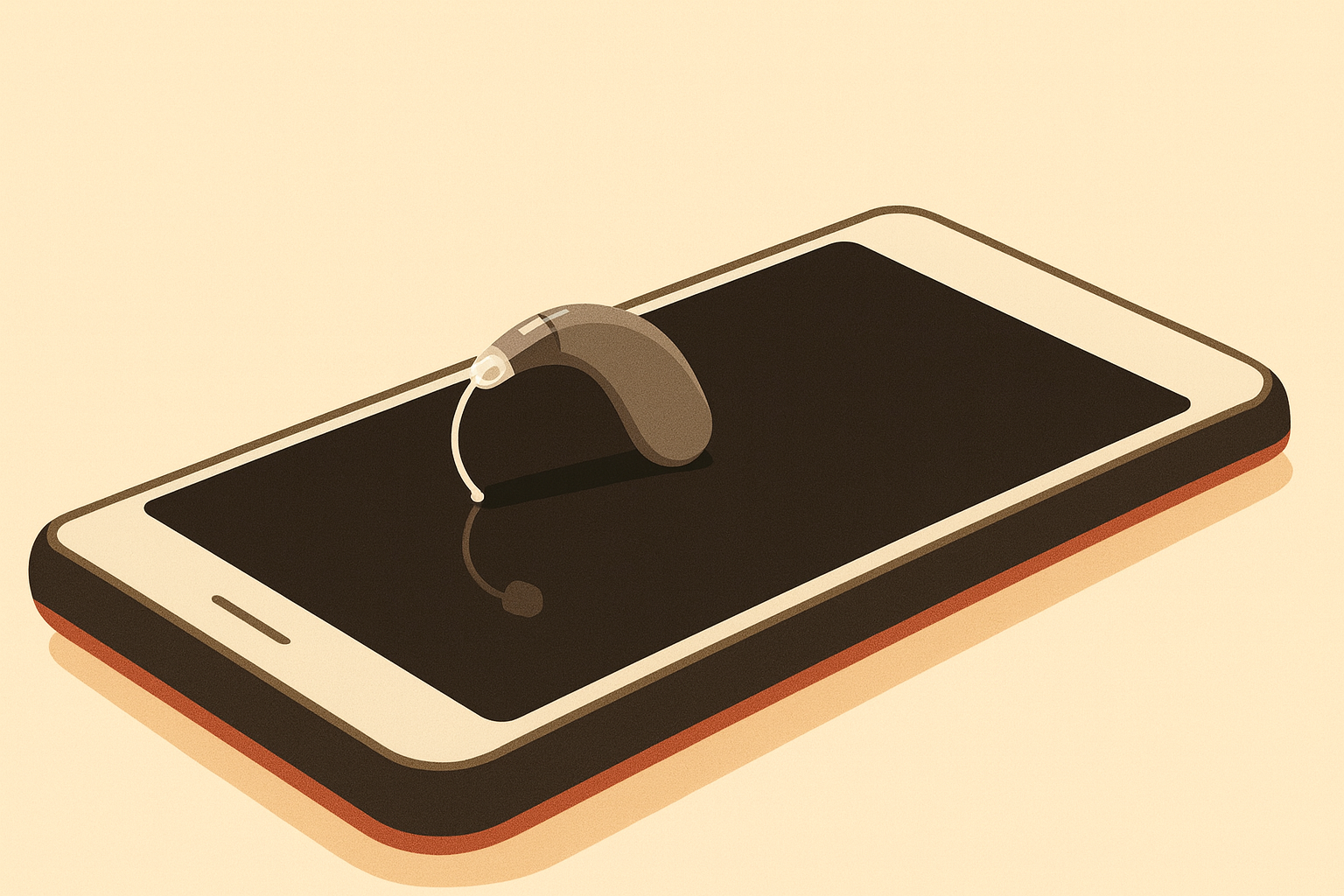
Bluetooth Hearing Aids: Pros, Cons and Buying Tips
Bluetooth Hearing Aids: Pros, Cons and Buying Tips
Managing phone calls is one of the most challenging and potentially frustrating activities for people with hearing loss. For years, hearing aid users needed to fumble with the “T” feature on the phone every time they needed to get a call. Adding Bluetooth technology to hearing aids simplifies this task by directly connecting your hearing aid to your phone, TV, and other electronics.
This post will walk you through how Bluetooth-enabled hearing aids work and give you buying tips.
How Do Bluetooth Hearing Aids Work?
Bluetooth is a technology that allows electronic devices to connect wirelessly to each other. This wireless connectivity in hearing aids allows hearing devices to link directly to other electronics.
Bluetooth-enabled hearing aids create a wireless connection, pairing them with every Bluetooth-enabled device, from computers to mobile phones and TVs. Bluetooth hearing aids compatibility with Android and iOS devices makes them versatile and enhances the wearer's quality of life.
Demystifying Bluetooth Technology in Hearing Aids
Bluetooth technology transmits data between two or more electronic devices with the help of high-frequency radio waves. There are two available versions of Bluetooth: classic and low-energy. Since hearing aids are small and have little battery capacity, they use Bluetooth Low Energy (BLE).
What Can You Do with a Bluetooth Hearing Aid?
- Control your hearing device from your smartphone via an app.
- Amplify and customise the streaming according to your device’s settings
- Minimise background noise at loud social events or crowded places.
- Your hearing aids also work as wireless earbuds to listen to music or stream videos.
- You can pair multiple devices at once. That means you can be paired with your phone while watching a TV show. To take a call, you pause the audio on your laptop or tablet and take it. You can also adjust the volume of each paired device separately.
Are Bluetooth Hearing Aids Worth It Compared to Non-Bluetooth Models?
Most hearing aids nowadays are digital, and there are not many differences between Bluetooth hearing aids and traditional hearing aids. Both perform the same functions regarding enhancing your hearing.
The main difference is Bluetooth's capability to connect to other electronic devices. With traditional hearing aids, you need to put your hearing aid in “T” every time you take a phone call, choose which side you want to hear it on and put your phone close to the hearing aid. With Bluetooth hearing aids, your device is paired to your phone, and you can manage it with your hearing device’s app.
Understanding the Cost of Bluetooth Hearing Aids
Bluetooth hearing aids are considered advanced hearing solutions. As such, they fall into the mid-to-high price range because of their advanced technology and functionality, ranging between 3000€ and 4500€. The brand, model, features, and specific settings can influence the price. Bluetooth hearing aids are more expensive because they have added features and advanced AI technology.
Among the advanced features you can find in Bluetooth hearing aids are the following:
- Speech improvement
- Feedback and background noise reduction,
- Tinnitus management,
- Rechargeable battery,
- Smartphone app.
When looking for a hearing aid with Bluetooth capabilities, we recommend putting financial considerations on the back burner. If your hearing tests reveal you have moderate to severe hearing loss, chances are the cheapest option available won’t help as much as more advanced models.
We recommend you invest in a high-quality hearing device that goes beyond amplifying sound, enhances speech understanding, and connects seamlessly to your phone and electronic devices. Your quality of life will improve and be worth every penny.
Advantages and Drawbacks of Bluetooth Hearing Aids: Unveiling the Features
When looking for a hearing aid, it is vital to make an informed choice and weigh the pros and cons of Bluetooth Hearing Aids.
Benefits of Bluetooth hearing aids,
Seamless Phone Connectivity and Hands-Free Communication
Bluetooth hearing aids for phone calls allow users to engage in hands-free conversation. The seamless phone connectivity lets you answer calls directly with your hearing aids without holding the phone to your ear. These hearing devices make phone conversations more comfortable by reducing background noise and acting as intra-canal wireless headsets.
Direct Streaming of Audio Content
You can use Bluetooth hearing aids to stream music from smartphones, tablets, and computers. Bluetooth lets you listen to music directly through your hearing aids without external accessories, giving you an immersive audio experience. There are also Bluetooth hearing aids for TV streaming, so you cannot miss your favourite series.
Enhanced Control and Personalization
Turning up the volume, taking a call and setting up a new program are some things you can do with your hearing aid’s smartphone app. These capabilities enable you to optimise your hearing aids for different listening situations and preferences.
Bluetooth hearing aids limitations
Considerations for device compatibility:
Some drawback of Bluetooth hearing aids is the device compatibility with smartphones. Top brands are compatible with Android and iPhone devices, but other brands are “made for Apple”, which are only compatible with Apple devices.
Limitations of battery life
The Bluetooth connectivity may drain the battery's life, requiring frequent battery replacements or recharging.
Top Bluetooth Hearing Aid Brands
At Auzen, we constantly update our selection of the most advanced hearing aid solutions. Here are some of the most popular:
|
Model |
Type of Hearing Aid |
|
Phonak Audeo Lumity L90-RT |
Receiver-in-canal (RIC) |
|
Oticon More |
Behind-the-ear (BTE) and receiver-in-canal (RIC) |
|
Signia Styletto 7AX |
Behind-the-ear and receiver-in-canal |

Phonak Audeo Lumity L90-RT
The Phonak brand is a pioneer in adding compatibility with Bluetooth and Android devices to their hearing aids. All the latest models of Phonak hearing aids are Bluetooth 4.2 certified. They work with any mobile device that supports Bluetooth, Hands-Free Profile (HFP) and Advanced Audio Distribution Profile. Any phone supporting Bluetooth 2.1 and later will support phone calls

Oticon More
The More Line is the first Oticon hearing aid with advanced AI capabilities, processing millions of sounds from real life to improve speech understanding. The More line boasts Bluetooth connectivity, simplifying remote audiology appointments and adjustments.

Signia Styletto 7AX
Designed for iPhone, the Signia Styletto 7AX is also compatible with Android. The AI-powered technology uses real-time voice recognition to enhance speech understanding. It also features noise reduction.

ReSound One RT96 DRWC
Unlike traditional hearing aids, ReSound’s One hearing aid places a microphone along the receiver in the user’s ear. The hearing device features two directional microphones on the behind-the-ear element and a third microphone alongside the receiver inside the in-ear part. By doing this, the company claims, the device mimics how sound is captured naturally by the shape of the ear. The ReSound One hearing device has Bluetooth connectivity with Android and iPhone devices.
Bluetooth Hearing Aid Buying Tips
When you are ready to buy your hearing aids, these tips can help you find the right one.
- Call your insurance and find out what your health provider covers. Your insurance may cover part of your hearing aid cost. If you are in Switzerland, you can consult our OASI and DI information page.
- Get your audiogram before you buy a hearing aid. A GP can refer you to an audiologist to take the test and interpret the results.
- Schedule an appointment with an Auzen audiologist to discuss your test results and get recommendations for hearing aids from an expert audiologist. Only buy hearing aids from a certified audiologist.
Wrapping Up
So, what’s the best Bluetooth-compatible hearing aid for you? Your daily activities and the devices you use will help narrow your choices. Before buying a Bluetooth-enabled hearing aid, consider which devices you use more. Do you receive phone calls daily? Is streaming audio and video from the TV and smartphone important for you? What other Bluetooth devices do you need to connect to your hearing aid?
The journey to finding the right hearing aid for you starts with an audiologist. After you have your audiogram, an Auzen audiologist will help you find the hearing aid that fits better with your hearing loss pattern.
The audiologist will consider your preferences and lifestyle needs to recommend a Bluetooth hearing aid compatible with your activities and devices.
Start by booking a free appointment with your Auzen audiologist.
Sources
URL: https://www.audiologyresearch.org/bluetooth-hearing-aids
https://www.medicalnewstoday.com/articles/bluetooth-hearing-aids-considerations-and-options
https://www.everydayhealth.com/healthy-living/bluetooth-hearing-aids/
https://www.healthyhearing.com/help/hearing-aids/bluetooth
https://www.forbes.com/health/hearing-aids/best-bluetooth-hearing-aids/
https://www.hearingtracker.com/bluetooth-hearing-aids

Leave a comment
This site is protected by hCaptcha and the hCaptcha Privacy Policy and Terms of Service apply.